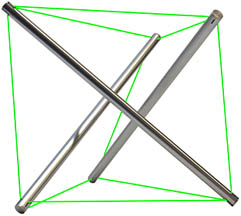The Three Kinds Of Tension
Lines
A tensegrity structure's
tension network is external to the compression struts and although the
tension system controls the structure as a total skin each separate line
connecting point-to-point exerts its control in a specific way.
|
|
"Edge"
tension lines define the edges and the sides of each module. The
three-way column has three edge lines for each module. In most cases,
edges carry less tension than draw or sling lines. |
|
|
"Draw"
tension lines pull the modules toward one another. In the three-way
column, each module is connected to each neighbor by three ascending
draws and three descending draw lines. |
|
|
"Sling"
tension lines suspend the modules, performing like the slings used
in rigging work. They connect one module to the next and are generally
in opposition to the draw lines. In a three-way column six slings
are required in order to link two modules. |
|
Above is a three-way module. In this simple figure all tension lines can be called edges: six end-edges and three side-edges. They define, roughly, a triangular prism. When viewed through the vertical axis the module has a left-rotation helix. The opposite is true when viewed from the side: the struts relate to one another in a clockwise or right-rotation helix. |
|
|
Right
Left
Right
helix |
 |
|
Three
module, three-way column
|
|
